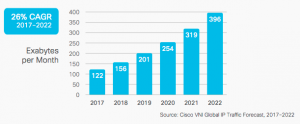Cisco: more internet traffic in 2022 than all other years combined, driven by video
More traffic will cross global networks in the year 2022 than in all years of the internet’s existence prior to that year, according to the latest research by Cisco.
Since it came to life in 1984, more than 4.7 zettabytes of IP traffic have flowed across the internet, equivalent to all the movies ever made crossing global IP networks in less than a minute, according to Cisco.
However, Cisco’s Visual Networking Index (VNI) predicts that by 2022, more IP traffic will cross global networks than in all prior ‘internet years’ combined up to the end of 2016. In other words, more traffic will be created in 2022 than in the 32 years since the internet started.
 Cisco predicts that global IP traffic will more than triple by 2022. Global IP traffic is expected to reach 396 exabytes per month by 2022, up from 122 exabytes per month in 2017, implying 4.8 zettabytes of traffic per year by 2022.
Cisco predicts that global IP traffic will more than triple by 2022. Global IP traffic is expected to reach 396 exabytes per month by 2022, up from 122 exabytes per month in 2017, implying 4.8 zettabytes of traffic per year by 2022.
Cisco also predicts that peak hour traffic will be comparatively more intense by 2022, growing at a 37% compound annual growth rate as against a 30% CAGR for average internet traffic.
Video, including gaming and multimedia, will make up 82% of all IP traffic, compared with 75% today, according to Cisco. The increase in the overall proportion will be driven by gaming traffic, which is expected to grow ninefold, and virtual and augmented reality, which is expected to account for 4.02 exabytes of traffic a month by 2022, up from 0.33 exabytes today.
Cisco predicts that households that still use linear TV will generate much less traffic than cord-cutters. Cord-cutting homes generated 141GB of traffic per month last year, compared with 82GB per month for homes with linear TV.
Cisco also predicts that homes with digital media adapters, although they will only represent 9% of all internet-connected TVs, will represent 18% of global internet-connected TV traffic by 2022, reflecting a decline in the importance of set-top boxes managed by service providers.
By 2022, 60% of the global population will be internet users, compared with 45% today, and more than 28 billion devices and connections will be online, according to the report. There will be 28.5 billion fixed and mobile personal devices and connections, up from 18 billion in 2017, or 3.6 networked devices/connections per person, up from 2.4 per person. However, over half of all devices and connections will be machine-to-machine by 2022, up from 34% in 2017.
According to Cisco, average broadband speeds will nearly double from 39Mbps to 75.4Mbps, while average WiFi connection speeds will more than double from 24.4Mbps to 54Mbps. Average mobile broadband speeds will triple from 8.7Mbps to 28.5Mbps.
The Asia-Pacific region will account for the lion’s share of traffic by 2022, generating 173 exabytes of traffic a month, followed by North America with 108 exabytes a month and western Europe with 50 exabytes a month.
“The size and complexity of the internet continues to grow in ways that many could not have imagined. Since we first started the VNI Forecast in 2005, traffic has increased 56-fold, amassing a 36 percent CAGR with more people, devices and applications accessing IP networks,” said Jonathan Davidson, senior vice-president and general manager, Service Provider Business, Cisco.
“Global service providers are focused on transforming their networks to better manage and route traffic, while delivering premium experiences. Our ongoing research helps us gain and share valuable insights into technology and architectural transitions our customers must make to succeed.”



